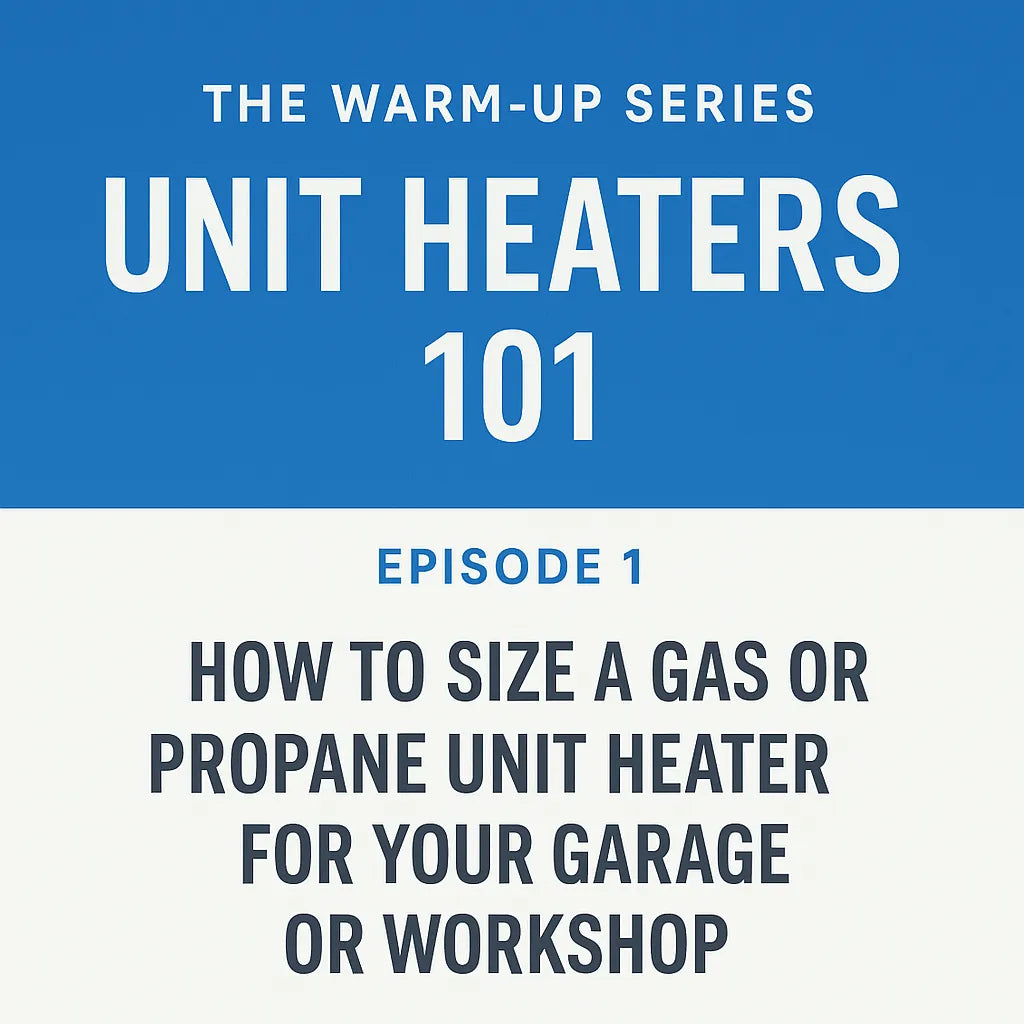This post is part of The Warm-Up Series: Unit Heaters 101 — your no-fluff guide to choosing, installing, and maintaining the perfect gas or propane unit heater.
The “Frozen-Garage” Problem We’ve All Faced
The first cold snap hits, you open the garage to grab something—and the air feels like it’s straight out of a walk-in freezer. You turn on your tiny space heater, but it’s no match.
That’s exactly how my neighbor Dave ended up asking me, “Hey, how big a heater do I actually need for this place?”
Sizing a unit heater isn’t guesswork; it’s science (with a dash of common sense). Get it wrong, and you’ll either freeze halfway through a project—or watch your energy bills climb faster than a holiday-light ladder.
Let’s break down how to find the right-size gas or propane unit heater for your space.
Why Proper Sizing Matters
A properly sized unit heater does three things better than any oversized or undersized model:
-
Heats evenly. You won’t have hot ceilings and cold feet.
-
Runs efficiently. The system cycles correctly, saving energy.
-
Lasts longer. Correct cycling prevents heat-exchanger stress and short cycling.
🧰 Pro Insight:
An oversized unit short-cycles (heats too fast, then shuts off). That on-off pattern actually uses more fuel and wears parts out faster than a slightly smaller model running steadily.
Step 1: Measure the Space
You’ll need:
-
Length × Width × Height (in feet)
-
Insulation level (tight, average, or drafty)
Here’s the simple sizing formula (adapted from Modine HVAC and Hawken Energy):
| Insulation Type | Multiplier (BTU per cu ft) |
|---|---|
| Well-insulated garage/workshop | 4–5 |
| Average insulation | 6–7 |
| Poor insulation / drafty | 8–10 |
Example: A 24′ × 30′ × 10′ garage = 7,200 cu ft. If it’s average insulation, 7,200 × 6 = 43,200 BTU/hr.
That’s your target output.
Step 2: Choose Between Gas and Propane
Both fuel types can power unit heaters beautifully—but there are subtle differences:
| Factor | Natural Gas | Propane |
|---|---|---|
| Heat content | ~1,030 BTU per cu ft | ~2,516 BTU per cu ft |
| Fuel storage | Piped supply | On-site tank |
| Efficiency potential | Typically lower heat content | Hotter flame = higher efficiency per unit |
| Operating cost | Often cheaper per unit in urban areas | May cost more per gallon but use less overall |
🧰 Pro Insight:
If you’re off the natural-gas grid, propane gives you independence and efficiency. If you already have a gas line, stay with gas—it’s simpler and cheaper to install.
For more detailed comparisons, the U.S. Department of Energy and Propane Education & Research Council have excellent homeowner fuel guides.
Step 3: Match Heater Output to Real-World Conditions
Other factors that nudge your sizing:
-
Ceiling height: Add 5–10% BTU for each foot over 10 ft.
-
Garage doors: Every uninsulated door adds roughly 10% load.
-
Climate zone: Northern states may need 15–25% more BTUs than the formula.
Don’t forget to check clearances and venting in your chosen model’s manual—safety and code compliance matter.
Step 4: Pick a Unit from The Furnace Outlet Collection
Once you’ve nailed your BTU range, it’s time to browse The Furnace Outlet’s Unit Heater Collection.
Each product lists BTU output, fuel type (gas or propane), and installation details.
If you’re around the 40–50 k BTU mark, consider a Goodman UH or Modine Hot Dawg model; for larger workshops or barns, go 60 k BTU and up.
🧰 Pro Insight:
When you’re between two sizes, lean slightly smaller if the space is tight and insulated—oversizing is the enemy of comfort.
Step 5: Double-Check Before You Buy
✅ Confirm fuel type available (gas line vs propane tank)
✅ Verify venting route and ceiling height
✅ Check electrical requirements for blower fan
✅ Make sure the mount location won’t blast directly on your workbench or vehicles
Ready to Heat Things Up?
Now that you know your sizing sweet spot, you’re halfway to a cozy, efficient workspace.
➡️ Next up in The Warm-Up Series: Unit Heaters 101 — we’ll walk through installation, start-up & maintenance tips so your new heater runs safely and efficiently all winter.
And when you’re ready to shop, head to The Furnace Outlet’s Unit Heaters to find the right model for your garage or workshop.
Author note: links and data drawn from Modine HVAC, Hawken Energy, and U.S. Department of Energy.







